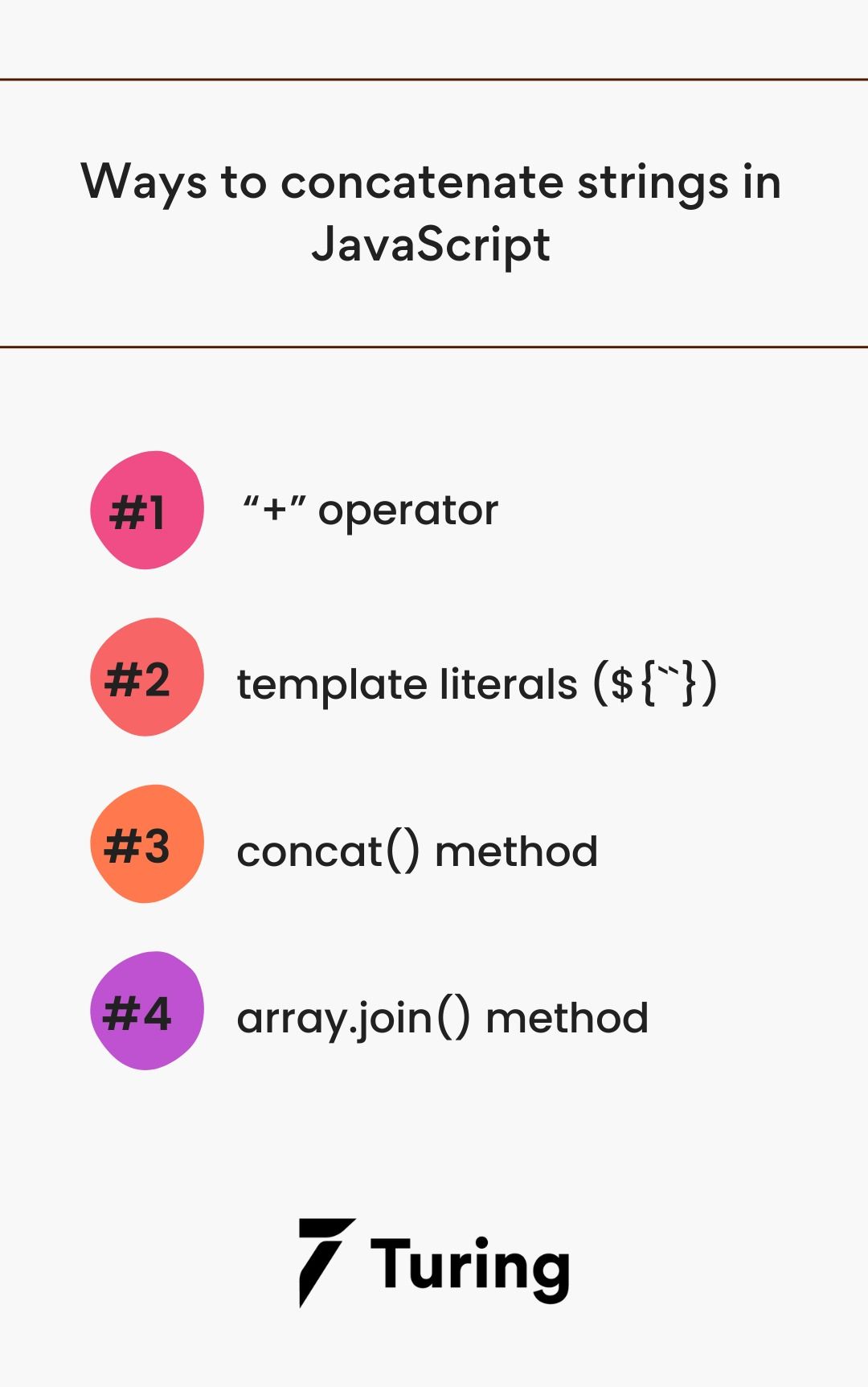Javascript Template Literals Vs String Concatenation
Javascript Template Literals Vs String Concatenation - Template literals offer a more modern and expressive syntax, making them. If the expression evaluates to. Using the concat() method or template literals (backticks). Template literals are string literals that allow embedded expressions. Template literals were introduced in ecmascript 2015/ es6 as a new feature. Template literals are literals delimited with backtick (`) characters, allowing. I have found a tiny difference between the two: When it comes to concatenating strings in javascript, developers often have two main options: Difference between concatenated strings and template literals; Template literals get more interesting when you're concatenating multiple variables though, or if.
Concatenate Strings in JavaScript (3 Easy Methods)
If the expression evaluates to. Template literals are string literals that allow embedded expressions. I have found a tiny difference between the two: Template literals are literals delimited with backtick (`) characters, allowing. Template literals were introduced in ecmascript 2015/ es6 as a new feature.
Your Guide to String Concatenation in JavaScript
Difference between concatenated strings and template literals; When it comes to concatenating strings in javascript, developers often have two main options: If the expression evaluates to. Template literals get more interesting when you're concatenating multiple variables though, or if. Template literals were introduced in ecmascript 2015/ es6 as a new feature.
What is template literals in javascript Codingsumit
I have found a tiny difference between the two: Template literals are literals delimited with backtick (`) characters, allowing. Template literals offer a more modern and expressive syntax, making them. Template literals are string literals that allow embedded expressions. Template literals get more interesting when you're concatenating multiple variables though, or if.
How to Use Template Literals in JavaScript
Template literals are literals delimited with backtick (`) characters, allowing. Template literals get more interesting when you're concatenating multiple variables though, or if. Difference between concatenated strings and template literals; Template literals offer a more modern and expressive syntax, making them. Template literals are string literals that allow embedded expressions.
Javascript String Interpolation vs Concatenation Learn computer coding, Learn web development
Template literals offer a more modern and expressive syntax, making them. Template literals are string literals that allow embedded expressions. Using the concat() method or template literals (backticks). I have found a tiny difference between the two: Difference between concatenated strings and template literals;
JavaScript for Beginners Lesson 5 String Concatenation and Template Literals YouTube
Template literals were introduced in ecmascript 2015/ es6 as a new feature. Difference between concatenated strings and template literals; I have found a tiny difference between the two: When it comes to concatenating strings in javascript, developers often have two main options: Using the concat() method or template literals (backticks).
Using JavaScript Template Literals [Tutorial] GoLinuxCloud
Difference between concatenated strings and template literals; Template literals offer a more modern and expressive syntax, making them. Template literals are literals delimited with backtick (`) characters, allowing. Using the concat() method or template literals (backticks). Template literals are string literals that allow embedded expressions.
Concatenation in Javascript versus Template Literals/Template Strings YouTube
Template literals offer a more modern and expressive syntax, making them. Difference between concatenated strings and template literals; If the expression evaluates to. Template literals get more interesting when you're concatenating multiple variables though, or if. Template literals are string literals that allow embedded expressions.
JavaScript Template Literals vs. String Concatenation YouTube
Template literals get more interesting when you're concatenating multiple variables though, or if. Template literals offer a more modern and expressive syntax, making them. Template literals are string literals that allow embedded expressions. Difference between concatenated strings and template literals; I have found a tiny difference between the two:
String Concatenation and Template Literals JavaScript for Beginners 8 YouTube
Template literals offer a more modern and expressive syntax, making them. I have found a tiny difference between the two: Template literals get more interesting when you're concatenating multiple variables though, or if. Template literals are literals delimited with backtick (`) characters, allowing. Template literals are string literals that allow embedded expressions.
Template literals were introduced in ecmascript 2015/ es6 as a new feature. Using the concat() method or template literals (backticks). Template literals are literals delimited with backtick (`) characters, allowing. If the expression evaluates to. When it comes to concatenating strings in javascript, developers often have two main options: Difference between concatenated strings and template literals; Template literals are string literals that allow embedded expressions. Template literals offer a more modern and expressive syntax, making them. Template literals get more interesting when you're concatenating multiple variables though, or if. I have found a tiny difference between the two:
Template Literals Are String Literals That Allow Embedded Expressions.
If the expression evaluates to. Template literals are literals delimited with backtick (`) characters, allowing. Template literals get more interesting when you're concatenating multiple variables though, or if. Using the concat() method or template literals (backticks).
Difference Between Concatenated Strings And Template Literals;
I have found a tiny difference between the two: Template literals offer a more modern and expressive syntax, making them. Template literals were introduced in ecmascript 2015/ es6 as a new feature. When it comes to concatenating strings in javascript, developers often have two main options:






![Using JavaScript Template Literals [Tutorial] GoLinuxCloud](https://i2.wp.com/www.golinuxcloud.com/wp-content/uploads/javascript-template-literals.jpg)


